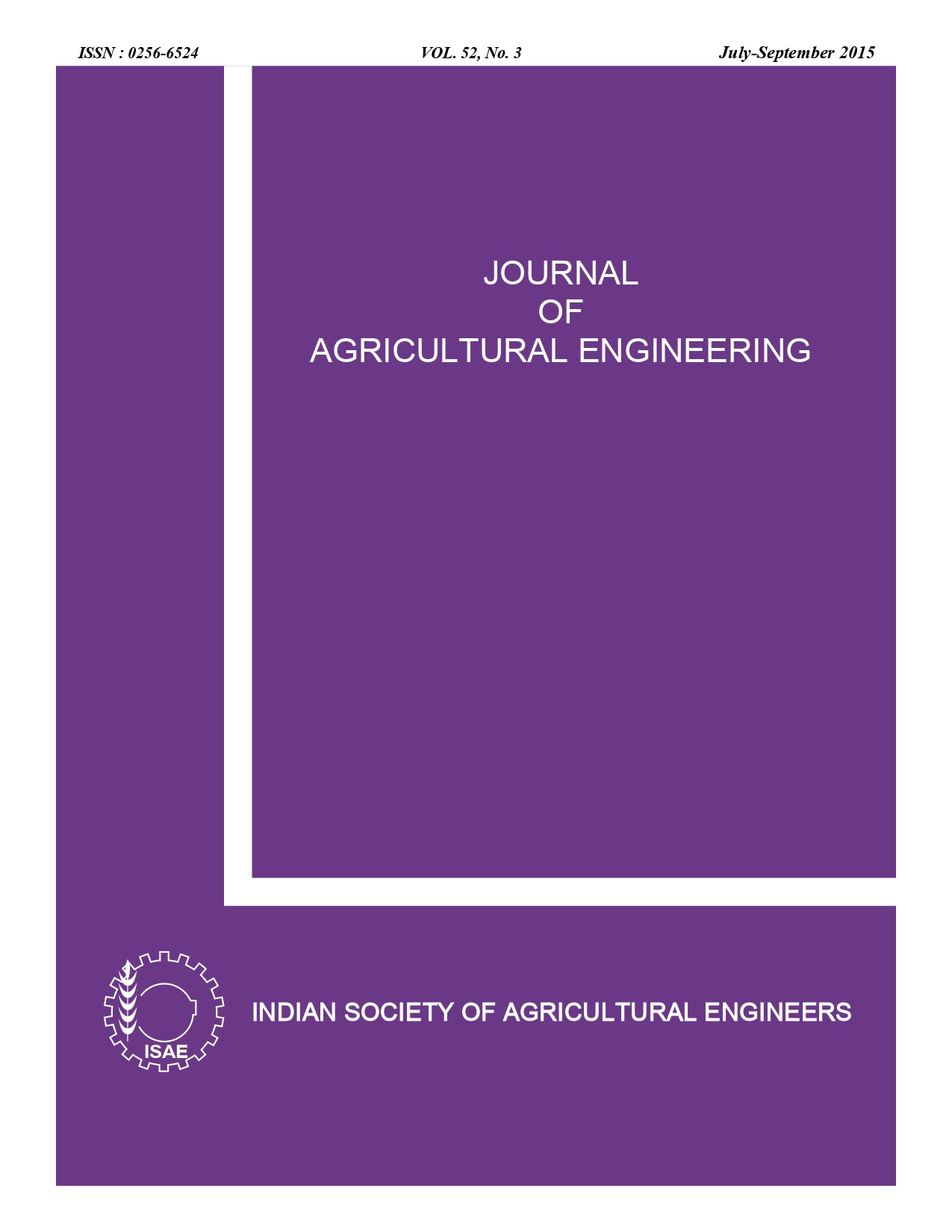Effect of Inoculum Concentration on Co-digestion of Kitchen Waste and Cattle Dung
DOI:
https://doi.org/10.52151/jae2015523.1582Keywords:
Anaerobic co-digestion, inoculum, batch reactorAbstract
Anaerobic co-digestion of kitchen waste and cattle dung mixed in the ratio of 1:1 with different concentrations of inoculums viz. 10%, 15%, 20% and 25%, respectively, was carried out in 10 l capacity lab scale batch reactors. Maximum average biogas yield (10.05 l.kg-1 TS fed) was observed in reactor operated with 25% inoculum followed by reactor with 20% (9.77 l.kg-1 TS fed), reactor with 15% (9.35 l.kg-1 TS fed) and reactor with 10% (9.27 l.kg-1 TS fed) inoculums. Maximum increase in N (18.49%), P (17.64%) and K (19.41%) was also observed in digested slurry of the reactor operated with 25% inoculum. The degradation of total solids (27.74%) as well as volatile solids (25.71%) was highest in the same reactor.
References
Alvarez R; Villca S; Liden G. 2005. Biomass production from llama and cow manure at high altitude. Biomass Bioenergy, 30, 66-75.
Alvarez R; Liden G. 2008. The effect of temperature variation on biomethanation at high altitude. Bioresour. Technol., 99, 7278-7284.
Antil R S; Singh A; Dahiya S S. 2002. Practical manual of soil and plant analysis. Department of Soil Science, CCS Haryana Agric. Univ. Hisar, India.
Bhattacharya A; Mishra M. 2003. Biodegradability of dairy cattle manure under dry anaerobic fermentation process. Indian J. Agric. Sci., 84, 9-11.
Callaghan F J; Wase D A J; Thayanithy K; Forster C F. 2002. Continuous co-digestion of cattle slurry with fruit and vegetable wastes and chicken manure. Biomass Bioenergy, 27, 71-77.
Cheremisinoff P N; Marresei A C. 1976. Energy From Solid Wastes. Marcel Dekker Inc. New York.
El-Mashad H M; Hang R. 2007. Anaerobic co-digestion of food waste and dairy manure. Trans. ASAE, 50, 1815-1821.
Eskicioglu C; Ghorbani M. 2011. Effect of inoculum/substrate ratio on mesophilic anaerobic digestion of bioethanoal plant whole stillage in batch mode. J. Process Biochem., 46(8), 1682-1687.
Forster-Carneiro T; Pe´rez M; Romero L I. 2008. Influence of total solid and inoculum contents on performance of anaerobic reactors treating food waste. Bioresour. Technol., 99, 6994–7002.
Hassan E A. 2003. Biogas production from forage and sugar beets: Process control and optimization, ecology and economy. Agrotech., 19, 70-72.
Jayalakshmi; Parmanik Krishna. 2007. Biogas production from kitchen waste. Biores. Technol., 95, 872-882.
Jones J B; Stadtman T C. 1997. Methanococcus vannielii culture and effects of selenium and tungsten on growth. J.Bacterial., 130, 1404-1406.
Koenig R A; Johnson C R. 1942. Colorimetric determination of P in biological materials. Ind. Eng. Chem. Anal., 14, 155-156.
Knol W; Most V M; Waaet D J. 2006. Biojas production by anaerobic digestion of prints and vegetable waste – a preliminary study. J. Sci. Food Agrie., 29, 822-830.
Kumar S; Jain M C. 1988. Dry anaerobic fermentation of cow dung-water hyacinth mixture in multiple batch digester. Res. Industry, 33, 162-166.
Li R; Chen S; Li X. 2009. Anaerobic co-digestion of kitchen waste and cattle manure for methane production. Energy Sources, 31(A), 1848-1856.
Lindner R C. 1944. Rapid analytical method for some of the more common inorganic constituents of plant tissues. Plant Physiol., 19, 76-89.
Lopes W; Silva L; Valderi D; Prasad S. 2004. Influence of inoculum on performance of anaerobic reactors for treating municipal solid waste. Biores. Technol., 94, 261–266.
Mata-Alvarez J; Mace S; Llabres P. 2000. Anaerobic digestion of organic waste. An overview of research achievements and perspectives. Biores. Technol., 74, 3-16.
Nagamani B; Ramasamy K. 1999. Biogas production technology: an Indian perspective. Curr. Sci., 77, 44-54.
Obaja D; Mace´ S; Costa J; Sans C; Mata-Alvarez J. 2003. Nitrification–denitrification and biological phosphorus removal in piggery waster using sequencing batch reactor. Biores. Technol., 87, 103–111.
Parkin G F; Owen W F. 1986. Fundamentals of anaerobic digestion of wastewater sludges. J. Environ. Eng., 112, 867-920.
Pathak B S; Jain A K; Dev D S. 1985. Biogasification of cattle dung and cattle dung–rice straw at different solid concentrations. Agric. Wastes, 13, 251-254.
Sans C; Mata-Alvarez J; Cecchi F; Pavan P; Bassetti A. 1995. Acidogenic fermentation of organic urban wastes in a plug-flow reactor under thermophilic conductions. Biores. Technol., 54, 105–110.
Sanders F A; Bloodgood D C. 1965. The effect of nitrogen to carbon ration on anaerobic decomposition. J. Water Pollut. Control Fed., 37, 1741.
Shivaraj D; Seenayya G. 1994. Optimum total solids content for the generation of biogas from poultry litter waste. Indian J. Environ. Health, 36, 115-118.
Wohalt J S. 1996. Thermophilic methane production from dairy cattle waste. Biol. Wastes, 32, 197-207.














